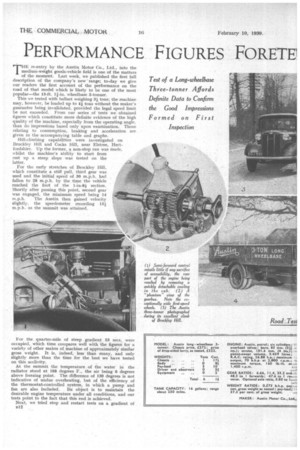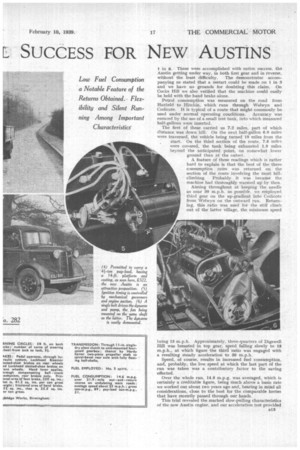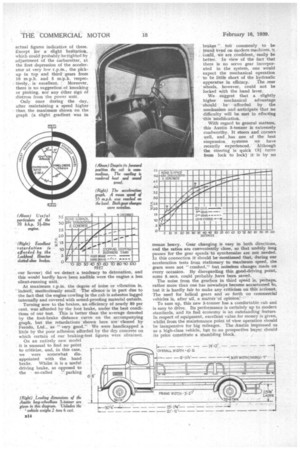PERFORMANCE FIGURES FORETE SUCCESS FOR NEW AUSTINS
Page 46

Page 47

Page 48

If you've noticed an error in this article please click here to report it so we can fix it.
THE re-entry by the Austin Motor Co„ Ltd., into the medium-weight goods-vehicle field is one of the matters of the moment. Last week, we published the first full description of the company's new range; to-day we give our readers the first account of the performance on the road of that model which is likely to be one of the most popular—the 13-ft. 11-in. wheelbase 3-tonner.
This we tested with ballast weighing 3i tons; the machine may, however, be loaded up to 4i tons without the maker's guarantee being invalidated, provided the legal speed limit be not exceeded. From our series of tests we obtained figures which constitute more definite evidence of the high quality of the machine, especially from the operating angle, than do impressions based only upon examination. Those relating to consumption, braking and acceleration are given in the accompanying table and graphs.
Hill-climbing capabilities were investigated on Brockley Hill and Cocks Hill, near Elstree, Hertfordshire. Up the former, a non-stop run was made, whilst the machine's ability to start from rest up a steep slope was tested on the latter.
For the early stretches of Brocldey Hill, which constitute a stiff, pull, third gear was used and the initial speed of 30 m.p.h. had fallen to 28 m.p.h. by the time the vehicle reached the foot of the 1-in-81 section. Shortly after passing this point, second gear was engaged, the minimum speed being 14 m.p.h. The Austin then gained velocity slightly, the speedometer recording 151 m.p.h. as the summit was attained.
For the quarter-mile of steep gradient 53 secs, were occupied, which time compares well with the figures for a variety of other makes of machine of approximately similar gross weight. It is, indeed, less than many, and only slightly more than the time for the best we have tested on this acclivity.
At the summit the temperature of the water in the radiator stood at 168 degrees F., the air being 6 degrees above freezing point. The difference of 130 degrees is not indicative of undue overheating, but of the efficiency of the thermostat-controlled system, in which a pump and fan are also included. Its object is to maintain the desirable engine temperature under rnall conditions, and our tests point to the fact that this end is achieved.
Next, we tried stop and restart tests on a gradient of 1 in 6. These were accomplished with entire success, the Austin getting under way, in both first gear and in reverse, without the least difficulty. The demonstrator accompanying us stated that a restart could be made on 1 in 3 and we have no grounds for doubting this claim. On Cocks Hill we also verified that the machine could easily be held with the hand brake alone.
Petrol consumption was measured on the road from Hatfield to Hitchin, which runs through Welwyn and Codicote. It is typical of a route that might commonly be used under normal operating conditions. Accuracy was ensured by the use of a small test tank, into which measured half-gallons were inserted.
The first of these carried us 7.2 miles, part of which distance was down hill. On the next half-gallon 6.9 miles were traversed, the vehicle being turned 10 miles from the start. On the third section of the route, 7.8 rnihs were covered, the tank being exhausted 1.9 miles beyond the anticipated point, on somewhat lower ground than at the outset.
A feature of these readings which is rather hard to explain is that the best of the three consumption rates was returned on the section of the route involving the most hillclimbing. Probably it was because the machine had thoroughly warmed up by then.
Aiming throughout at keeping the needle as near 30 m.p.h. as possibk, we employed third gear on the up-gradient into Codicote from Welwyn on the outward run. Returning, this ratio was used for the stiff climb out of the latter village, the minimum speed being 13 m.p.h. Approximately, three-quarters of Digswell Hill was breasted in top gear, speed falling slowly to 18 m.p.h., at which figure the third ratio was engaged with a resulting steady acceleration to 30 m.p.h.
Speed, of course, results in increased fuel consumption, and, probably, the low speed at which the last part of the run was taken was a contributory factor to the saving effected.
Over the whole run, 14.6 m.p.g. was averaged, which is certainly a creditable figure, being much above a basic rate we worked out about two years ago and, beating in mind all considerations, close to the best for the comparable lorries that have recently passed through our hands.
This trial revealed the marked slow-pulling characteristics of the new Austin engine, and our acceleration test provided a13
actual figures indicative of these. Except for a slight hesitation, which could probably berighted by adjustment of the carburetter, at the first depression of the accelerator at very low r.p.m., the pickup in top and third gears from 10 m.p.h. and 5 m.p.h. respec tively,is excellent. Moreover, there is no suggestion' of knocking or pinking, nor any other sign of distress from the power unit.
Only once during the day, after maintaining a speed higher than the maximum shown on the graph (a slight gradient was in
our favour) did we detect a tendency to detonation, and this would hardly have been audible were the engine a less silent-running unit.
At maximum r.p.m. the degree of noise or vibration is, indeed; meritoriously small; The silence is in part due to the fact that the engine.cowling in the cab is asbestos lagged internally and covered with sound-proofing material outside.
• Turning now to the brakes, an efficiency of nearly 80 per cent, was afforded by the foot brake, uncler the best conditions of our test This is better than the average denoted by the foot-brake distance curve on the accompanying graph, but the retardations shown here are classed by Ferodo, Ltd., as "very good." We were handicapped a little by the poor adhesion afforded by the dry. concrete on which certain of our braking,test figures were obtained.
On an entirely new model . it is unusual to find no point to criticize, and, in this case, we were somewhat disappointed with the hand brake_ Whilst it is a useful driving brake, as opposed to the so-called parking brakos ". tab commonly to be . found eyed on modern machines, it Could, we are confident, easily be better, In view of the fact that there is no servo gear incorporated in the system, one would expect the mechanical operation to be little short of the hydraulic apparatus in effieacy. The mar wheels, however, could not be locked with the hand lever.
We suggest that a slightly higher mechanical advantage should be.-afforded by the mechanism and -anticipate that no difficulty will be met in effecting this 'Modification.
With regard to general matters, this Austin 3-tonner is extremely roadworthy. It steers and corners well, and ,.has one of the best suspension systems .we have recently experienced. Although the Steering is quick (3,li turns from lock to lock) it' is by no means heavy. Gear chaoging is easy in both directions, and the ratios are conveniently Close, so that unduly long pauses for the gear speeds tci synchronize are not needed. In this• connection it. should be' xtentioned that, during our acceleration tests from stationary to maximum speed, the gears were not "crashed," but noiseless changes made on every occasion. By disregarding this good-driving point, some 5. secs. conld probably have been saved.
The noise from the gearbox in third speed is, perhaps, rather more than one has nowadays become accustomed to, but it is hardly fair to make any criticism on this acCount The need for helical gears and so forth on commercial vehicles is, after all, a matter'of opinion:
To sum up, this new 3-tormer has a comfortable cab and is easy to drive. Its performance is certainly up to modern standards, and its fuel economy is *an outstanding feature. In respect of equipment, excellent value for money is 'given, whitst from the maintenance point 'of view operation should be inexpensive for big mileages. The Austin impressed us as a high-class vehicle, but to no prospective buyer should its price constitute a stumbling block.




























































































